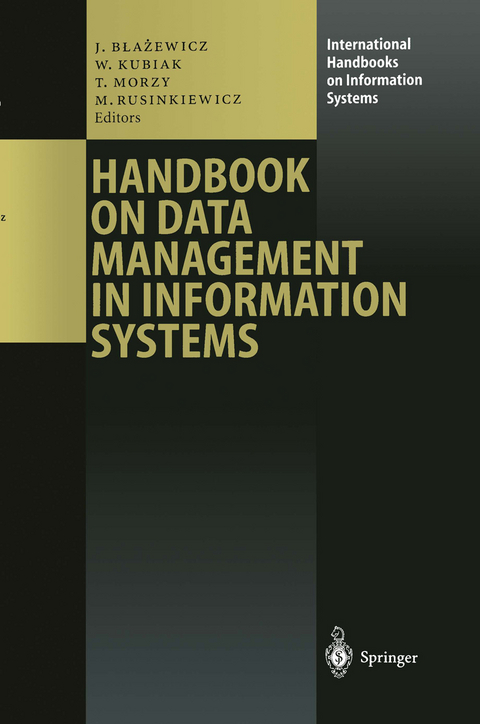
Handbook on Data Management in Information Systems
Springer Berlin (Verlag)
978-3-642-53441-6 (ISBN)
1. Management of Data: State-of-the-Art and Emerging Trends.- 1 Introduction.- 2 Survey of the Volume.- 2. Database Systems: from File Systems to Modern Database Systems.- 1 Introduction - Database Concepts.- 2 Database System Generations.- 3 Network Database Systems.- 4 Hierarchical Database Systems.- 5 Relational Database Systems.- 6 Object-Oriented Database Systems.- 7 Federated, Mediated Database Systems and Data Warehouses.- 8 Conclusions.- 3. Data Modeling.- 1 Introduction.- 2 Early Concerns in Data Management.- 3 Abstraction in Data Modeling.- 4 Semantic Data Models.- 5 Models of Reality and Perception.- 6 Toward Cognition-Based Data Management.- 7 A Cognitive Approach to Data Modeling.- 8 Research Directions.- 4. Object-Oriented Database Systems.- 1 Introduction and Motivation.- 2 Object-Oriented Data Modeling.- 3 The Query Language OQL.- 4 Physical Object Management.- 5 Architecture of Client-Server-Systems.- 6 Indexing.- 7 Dealing with Set-Valued Attributes.- 8 Query Optimization.- 9 Conclusion.- 5. High Performance Parallel Database Management Systems.- 1 Introduction.- 2 Partitioning Strategies.- 3 Join Using Inter-Operator Parallelism.- 4 ORE: a Framework for Data Migration.- 5 Conclusions and Future Research Directions.- 6. Advanced Database Systems.- 1 Introduction.- 2 Preliminaries.- 3 Data Models and Modeling for Complex Objects.- 4 Advanced Query Languages.- 5 Advanced Database Server Capabilities.- 6 Conclusions and Outlook.- 7. Parallel and Distributed Multimedia Database Systems.- 1 Introduction.- 2 Media Fundamentals.- 3 MPEG as an Example of Media Compression.- 4 Organisation and Retrieval of Multimedia Data.- 5 Data Models for Multimedia Data.- 6 Multimedia Retrieval Sequence Using Images as an Example.- 7 Requirements for MultimediaApplications.- 8 Parallel and Distributed Processing of Multimedia Data.- 9 Parallel and Distributed Techniques for Multimedia Databases.- 10 Case Study: Cairo - Cluster Architecture for Image Retrieval and Organisation.- 11 Conclusions.- 8. Workflow Technology: the Support for Collaboration.- 1 Introduction.- 2 Application Scenario and Collaboration Requirements.- 3 Commercial Technologies Addressing Collaboration Requirements.- 4 Evaluation of Current Workflow Management Technology.- 5 Research Problems, Related Work, and Directions.- 6 Summary.- 9. Data Warehouses.- 1 Introduction.- 2 Basics.- 3 The Database of a Data Warehouse.- 4 The Data Warehouse Concept.- 5 Data Analysis of a Data Warehouse.- 6 Building a Data Warehouse.- 7 Future Research Directions.- 8 Conclusions.- 10. Mobile Computing.- 1 Introduction.- 2 Mobile Computing Infrastructure.- 3 Mobile Computing Software Architectures and Models.- 4 Disconnected Operation.- 5 Weak Connectivity.- 6 Data Delivery by Broadcast.- 7 Mobile Computing Resources and Pointers.- 8 Conclusions.- 11. Data Mining.- 1 Introduction.- 2 Mining Associations.- 3 Classification and Prediction.- 4 Clustering.- 5 Conclusions.- List of Contributors.
| Erscheint lt. Verlag | 20.7.2012 |
|---|---|
| Reihe/Serie | International Handbooks on Information Systems |
| Zusatzinfo | IX, 578 p. |
| Verlagsort | Berlin |
| Sprache | englisch |
| Maße | 155 x 235 mm |
| Gewicht | 896 g |
| Themenwelt | Informatik ► Theorie / Studium ► Algorithmen |
| Schlagworte | Architectures • Database • Databases • Data Management • data model • Data processing • information system • mobile computing • Modeling • Motivation • MPEG • Optimization • Performance • Relational Database • service-oriented computing • Transaction management • Warehousing • Workflow |
| ISBN-10 | 3-642-53441-4 / 3642534414 |
| ISBN-13 | 978-3-642-53441-6 / 9783642534416 |
| Zustand | Neuware |
| Haben Sie eine Frage zum Produkt? |
aus dem Bereich


